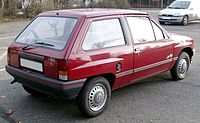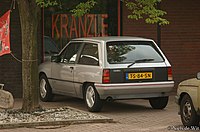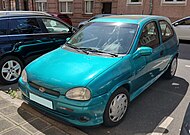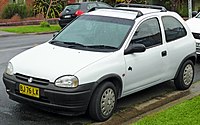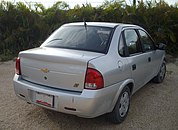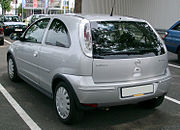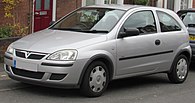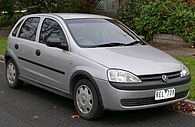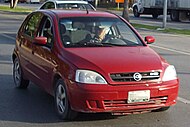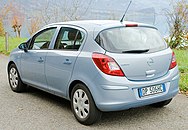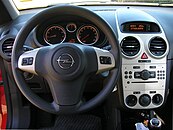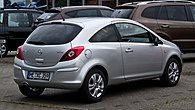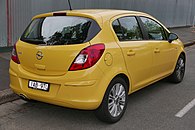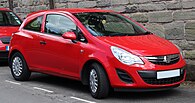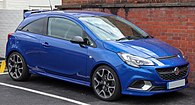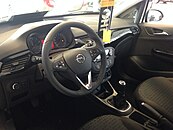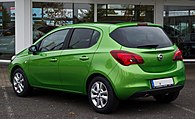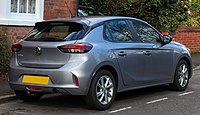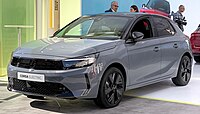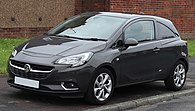Opel Corsa
| Opel Corsa | |
|---|---|
 Opel Corsa F | |
| Overview | |
| Manufacturer |
|
| Also called |
|
| Production |
|
| Body and chassis | |
| Class | Supermini (B) |
| Layout | Front-engine, front-wheel-drive |
| Chronology | |
| Predecessor | Opel Kadett City Vauxhall Chevette |
The Opel Corsa is a supermini car[1][2][3] engineered and produced by the German automobile manufacturer Opel since 1982. Throughout its existence, it has been sold under a variety of other brands owned by General Motors (most notably Vauxhall, Chevrolet, and Holden) and also spawned various other derivatives.
At its height of popularity, the Corsa became the best-selling car in the world in 1998, recording 910,839 sales with assembly operations in four continents and was sold under five marques with five different body styles.[4] By 2007, over 18 million Corsas had been sold globally.[5]
Corsa A (S83; 1982)
[edit]| Corsa A | |
|---|---|
 | |
| Overview | |
| Model code | S83 |
| Also called | Vauxhall Nova |
| Production | 1982–1993 |
| Assembly | Spain: Zaragoza Yugoslavia: Kikinda (IDA-Opel) |
| Body and chassis | |
| Body style | |
| Powertrain | |
| Engine | |
| Transmission | 4/5-speed manual |
| Dimensions | |
| Wheelbase | 2,343 mm (92.2 in) |
| Length | 3,622–3,955 mm (142.6–155.7 in) |
| Width | 1,532–1,540 mm (60.3–60.6 in) |
| Height | 1,360–1,365 mm (53.5–53.7 in) |
| Curb weight | 735–865 kg (1,620–1,907 lb) |
The front-wheel drive Opel Corsa was first launched in September 1982. It went on sale first in France, Italy, and Spain - markets where small cars represented from 34 to 43 percent of overall automobile sales.[6] Sales across the remainder of Europe were to have begun by March 1983. General Motors' internal code for the Corsa/Nova was the S-car.[7] The S-car designation had originally been applied to an abandoned supermini proposal from the early 1970s, which evolved into the 3-door hatchback ("City") version of the Opel Kadett C/Vauxhall Chevette, for which the Corsa/Nova acted as a de facto replacement. The Corsa was GM Europe's entry into the burgeoning supermini market - a market in which Opel/Vauxhall were not yet represented, as the Kadett C/Chevette was not a true supermini in the sense that it was rear wheel drive, while its successor - the Kadett D/Astra - competed in the larger C-segment, thus leaving a gap at the bottom of the range. The new car would therefore follow in the template already set by established superminis such as the Fiat 127, VW Polo and Ford Fiesta in using a transverse-engined, front wheel drive layout.
Built in Zaragoza, Spain, the first Corsas were three-door hatchback and two-door saloon models, with four-door and five-door versions added in 1984. In certain markets, commercial "van" models were also sold, with or without rear windows depending on local requirements. In mainland Europe, the saloon versions were known as the "Corsa TR" until May 1985 and had subtly altered styling - the distinctive wheelarch blisters of the hatchbacks were deleted and the saloons used a traditional "eggcrate" grille instead of the hatchback's integrated bumper/four-bar grille. The saloons were intended to appeal to customers of the Opel Kadett C and Vauxhall Chevette who still desired a traditional three-box sedan shape - while it did not sell particularly well in most of Europe, the TR was popular in Spain and Portugal among other markets. While only taking ten percent of French Corsa sales during the car's first half-year, the TR represented half of all Corsas sold in Spain.[8]
The basic trim level was called just the Corsa, which was followed by the Corsa Luxus, Corsa Berlina, and the sporty Corsa SR. The SR receives a spoiler which surrounds the rear window, alloy wheels, checkered sport seats, and a somewhat more powerful 70 PS (51 kW) engine.[9] Six years later, the Corsa received a facelift, which included a new front fascia and some other minor changes. The models were called LS, GL, GLS, and GT.
The Corsa A was known in the United Kingdom market as the Vauxhall Nova[10] —Nova being a legacy nameplate which had been used elsewhere in the GM empire with Corsa being rejected as it sounded too much like coarser.[citation needed] It launched in April 1983, following a seven-month-long union dispute due to British workers' anger over the car being built in Spain, in contrast to the rival Ford Fiesta and Austin Metro.[11] In addition, there was a disparity concerning import tariffs, as while cars exported from Spain to the European Community were subject to tariffs of only 4.4%, those exported in the other direction were subject to tariffs of 36.7%.[10]
Power first came from 1.0 L 45 hp, 1.2 L 55 hp, and 1.3 L 70 hp petrol engines. (The first engines were all equipped with carburetors; fuel injection came later, but never for the 1.0.) The engines were based on the well proven Family I design,[citation needed] except for the 1.0 L and early 1.2 L engines, which were based on the OHV unit from the Kadett C.
There was also an Isuzu-built, 67 PS (49 kW) 1.5 L turbo diesel engine available, which was also used in the Isuzu Gemini at around the same time. The diesel, along with the sporty GSi, joined the line up at the Frankfurt Motor Show in May 1987.[12] The engines and most of the mechanical componentry were derived from those used in the Astra/Kadett. In September 1987 the Corsa received a light facelift, with a new grille that was now the same on hatchbacks and sedans, an updated interior, and other slight changes. For the 1989 model year, the 1.3 was bored out to 1.4 liters. Power remained the same, although torque increased.
A rare "Sport" model was produced in 1985 to homologate for the sub 1,300 cc class of Group A for the British Rally Championship.[citation needed] These Sport models were white and came with unique vinyl decals, a 13SB engine with twin Weber 40 DCOE carburettors, an optional bespoke camshaft, a replacement rear silencer, and few luxuries. This gave 93 hp and a top speed of 112 mph (180 km/h) with a 0–60 mph time of 8.9 seconds. These are by far the rarest models (500 produced) and thus acquire a high market price if one does become available.
A 1.6 L multi point fuel-injected engine with 101 PS (74 kW) at 5600 rpm (98 PS or 72 kW in the catalysed version) and capable of 186 km/h (116 mph) was added to the Corsa/Nova at the 1987 Frankfurt Motor Show, giving decent performance and being badged as a GSi ("Nova GTE" in pre-facelift models in the United Kingdom, later models were all called GSi).[13]
The GSi's engine mapping had been carried out by Opel tuning specialists Irmscher. A model with the 82 PS (60 kW) 1.4 L multi-point fuel-injected engine, which was otherwise mechanically identical to the GSi, also became available as the Nova SRi in the United Kingdom. In January 1988, a turbocharged version of the Isuzu diesel engine was introduced, with power increased to 67 PS (49 kW).[12]
The design was freshened in September 1990, with new bumpers, headlights, grille, and interior, but it was clearly recognisable as a gentle makeover of an early 1980s design when it had to compete with the latest two all-new superminis in Europe – the Peugeot 106 and the Renault Clio. The 1992 model year saw the 1.0 litre models dropped from the line up, as the Opel OHV engine could not comply with the upcoming Euro 1 emission standard.
-
Rear view, 1987 facelift model
-
Opel Corsa GT (pre-facelift)
-
Opel Corsa GT 1.3 (1987)
-
Opel Corsa TR two-door (1982–1987)
-
Rear view
-
Opel Corsa five-door (1985–1987), note different grille from Corsa TR
-
Opel Corsa four-door (1990–1993; rear)
-
1990-1993 facelift model, "Strada" special edition (NL)
-
1988 Opel Corsa GSi (rear)
-
1989 Opel Corsa Van
-
The Michalak Spider was one of many tuned versions of the Corsa available in the era
Vauxhall Nova
[edit]The Corsa A was rebadged as the Vauxhall Nova between April 1983 and March 1993 for the United Kingdom only, as it had been decided to phase out the Vauxhall brand entirely in favor of Opel in the Republic of Ireland. ("Nova" is a trademark which GM had already used in North America). It effectively replaced the aging Chevette, which finished production in January 1984. Nearly 500,000 Novas were sold in Britain over the next ten years, but by February 2016, only 1,757 were still on the road.[14] In its best year, 1989, it was Britain's seventh best selling car with more than 70,000 sales. All Nova models were manufactured in Spain, with the first customers in the United Kingdom taking delivery of their cars in April 1983. It gave Vauxhall a much needed modern competitor in the supermini market in the United Kingdom, as the Chevette was older than the majority of its main competitors which consisted of the Ford Fiesta and the Austin Metro. With the late 1990 facelift a small van version arrived, called the Vauxhall Nova Van.[15]
Sales in the United Kingdom were strong right up to the end, but by the time the last Nova was built in the beginning of 1993, it was looking very dated in comparison to more modern rivals like the Peugeot 106 and the Renault Clio.[citation needed] Vauxhall dropped the Nova name in 1993 when their version of the Opel Corsa B made its debut, and later models were sold as the Vauxhall Corsa instead. This was the second Vauxhall to adopt the same model name as the Opel version, the first being the Senator.
A television advert in 1986 featured the Ritchie Valens hit "La Bamba" playing in the background, and used CGI to allow a Nova to drive over vehicles in a busy city. Another advert from 1990 featured a Nova as a pet, CGI allowing it to jump through a traffic jam and briefly play a hotrod whilst stopped at traffic lights. The end featured a homage to Wacky Races, with the Nova laughing like Muttley.[16] This advert featured Angus Deayton.
-
Vauxhall Nova five-door (1989–1990)
-
Vauxhall Nova five-door (1990–1993)
-
Vauxhall Nova GTE
Corsa B (S93; 1993)
[edit]| Corsa B | |
|---|---|
 | |
| Overview | |
| Model code | S93 |
| Also called | Vauxhall Corsa Chevrolet Corsa Chevrolet Corsa Classic Chevrolet Corsa Plus (Chile) Chevrolet Chevy (Mexico) Chevrolet Classic Chevrolet Sail (China) Buick Sail (China) Holden Barina (Australasia) Opel Vita (Japan) Jilin Jiangbei Meilu JJ7090 (China)[17] |
| Production | 1993–2000 (Europe and Thailand)[18] 1994–2016 (Brazil) 1997–2016 (Argentina) 1995–2011 (Mexico) 1993–1996 (China; Meilu JJ7090; CKD) 2001–2005 (China; Buick) 2005–2009 (China; Chevrolet) |
| Assembly |
|
| Designer | Hideo Kodama |
| Body and chassis | |
| Body style | 3/5-door hatchback 4-door saloon 5-door estate car 2-door coupé utility (pickup) |
| Platform | GM4200 platform |
| Related | Opel Combo B Opel Tigra A Chevrolet Celta Chevrolet Sail |
| Powertrain | |
| Engine | |
| Transmission | 4-speed manual [citation needed] 5-speed manual 4-speed automatic |
| Dimensions | |
| Wheelbase | 2,443 mm (96.2 in) (hatchback, saloon, estate car)[24] 2,480 mm (97.6 in) (pickup)[25] |
| Length | 3,729 mm (146.8 in) (hatchback, 1992–1998)[24] 3,741 mm (147.3 in) (hatchback, 1998–2000)[24] 4,026 mm (158.5 in) (saloon, estate car)[26][27] 4,153 mm (163.5 in) (pickup)[25] |
| Width | 1,610 mm (63.4 in) |
| Height | 1,440 mm (56.7 in) |
In April 1993, the Corsa B was unveiled and in the United Kingdom, Vauxhall dropped the Nova name, with the car from now being known as the Corsa.[28] In May 1994, it was launched by Holden in Australia, as the Barina, replacing a version of the Suzuki Swift sold under that name.[29] This proved a success, and was the first Spanish built car to be sold in significant volumes in the Australian market.[30]
Unlike the previous model, there was no saloon version for the European market, but one was designed in Brazil for the Latin American market, as saloons were much preferred to hatchbacks there. This was also introduced in South Africa and India. An estate car, panel van and pickup truck were also introduced, and a convertible version was produced for the Australian market, called the Holden Barina Cabrio. Chevrolet Corsa Sedan, Chevrolet Corsa Pick Up and Chevrolet Corsa Wagon were Designed by Wagner Montes Cla Dias[31] in the GM Brasil Studios in São Caetano do Sul.
Italy was the only European country where the Argentinian-built wagon version was offered, which meant that the Italian importer had to shoulder the entire cost of homologation.[32] In Italy, the wagon was offered with a 1.4-liter 16-valve petrol engine or the 1.7-liter naturally aspirated diesel. The Corsa also spawned a small coupé, named the Opel Tigra.
Four cylinder power came from 1.2, 1.4, and 1.6 litre Family 1 petrol engines, as well as an economical 1.5 L turbodiesel engine. Most cars received a five speed manual transmission, although a four speed automatic was also available with certain engines. In the first few years, a four speed manual was also available coupled to the smallest 1.2 litre engine.[33]
1.0 L three cylinder and 1.2 L four-cylinder Family 0 economy version was launched in 1997, and a Lotus-tuned suspension was added as well as an exterior refresh.[34]
The saloon model was built and sold in Latin America as the Chevrolet Corsa Classic until 2010 when it was replaced with the model previously released for China in 2005 as the Buick Sail. A budget version introduced for the Brazilian market, the Chevrolet Celta, has bodywork resembling the end of the 1990s Vectra and Astra. The Celta was sold in Argentina as the Suzuki Fun for a certain period.
In 2011, General Motors stopped representing Suzuki in Argentina, so the Celta reverted to its original name under the Chevrolet brand. Argentinian production began in September 1997, where it was the first locally built Chevrolet passenger car since 1978.
The Latin American Corsa received a small facelift in 1999, with smoother bumpers, and from April 2002 (when the new Corsa II was introduced) the Corsa B began being marketed as the "Corsa Classic"[35] until 2010, where it became the "Classic" when the Corsa B derived Chevrolet Sail and Chevrolet Celta replaced it. Production finally ceased in October 2016.[36]
The saloon and estate car versions were produced in China by Shanghai GM as Buick Sail and Buick Sail S-RV, respectively from June 2001 to February 2005. That year, they received a facelift and became known as the Chevrolet Sail and SRV. In September 2006, Chile became the first country outside China to receive the Chinese assembled Sail; it is called the Chevrolet Corsa Plus there, available as a four-door saloon with a 1.6 L 92 PS (68 kW) engine. The Corsa Plus includes dual front airbags, anti-lock brakes, air conditioning, electric windows and central locking as standard equipment.
In India, the hatchback, saloon and estate car versions were sold as the Corsa Sail, Corsa (or Corsa Joy) and Corsa Swing respectively until the end of 2005. The hatchback model was still being produced, and extensively marketed in South Africa as the Corsa Lite under the Opel branding until 2009; at which point it was discontinued.
In Thailand, the Corsa was available as an Opel with a fuel-injected 8V 1.4-litre engine and "Joy" and "Swing" variants, both available with three or five-door and either a manual or an automatic gearbox.
-
Opel Corsa five-door
(1993–1997) -
Opel Corsa three-door
(1997–2000) -
Opel Corsa five-door (1997–2000)
-
Opel Corsa Caravan
-
Opel Corsa GSi 16V (1993–1995)
-
Vauxhall Corsa three-door (pre facelift)
-
Vauxhall Corsa five-door (facelift)
-
Holden Barina three-door (pre-facelift)
-
Holden Barina cabrio (facelift)
-
Interior
-
Buick Sail sedan (China)
-
Buick Sail SRV (China)
-
Chevrolet Sail (China)
Safety
[edit]| Test | Score | Rating |
|---|---|---|
| Adult occupant: | N/A | |
| Pedestrian: | N/A |
The Corsa was updated in 1997, resulting in different styling options and better safety features:
| Test | Score | Rating |
|---|---|---|
| Adult occupant: | 18 | |
| Pedestrian: | 14 |
The Corsa Classic in its most basic Latin American market configuration with no airbags received 1 star for adult occupants and 1 star for toddlers from Latin NCAP in 2011 (obsolete protocol).[39]
South Africa
[edit]The Corsa B was manufactured in South Africa and first entered the market in November 1996, featuring three models (Lite, 130i and 130iS), all having the same 1.3L (13NE) 8 valve engine producing 58 kW. In 1999 the range was updated, dropping the 1.3L engine in favor of a 1.4 (14NE) producing 65 kW and a 1.6 (C16SE) producing 75 kW, both still being 8 valve engines. From model year 2001, a facelift was performed, resulting in some front and rear styling changes, including a new front bumper, bonnet and clear headlight lenses and new taillight lenses featuring a "bubble" look. The Corsa B continued in production post 2002, when the Corsa C was introduced, with only the 1.4-litre engine remaining available in various "Lite" trim models (three-door only) until production ultimately ceased in 2007. Alongside the three-door hatchback, four-door sedan and pickup derivatives were also available earlier on.
Specifications differed compared to European Corsa B models, with the following features offered in Europe and UK never being offered on South African models:
- 16 valve engines (all models used the older SOHC 8 valve engine design)
- ABS brakes
- Airbags
- Electric windows and mirrors were never offered on any three-door models and only on the top spec (160iE) four-door sedan
- No automatic transmission option was ever offered
| Models | Engine used |
|---|---|
| Lite, 130i, 130iS, 130iE | 1.3L (13NE) 58 kW |
| Lite, Lite+, Lite Sport, Chill, 1.4i, 1.4iS | 1.4L (14NE) 65 kW |
| 160i, 160iS, 160iE, GSi, GSi Ltd | 1.6L (C16SE) 75 kW |
Mexico
[edit]For 1995, General Motors de México first marketed the Corsa B as the Chevrolet Chevy.[41] For 2004 (after the Corsa C had been introduced in 2002), a Mexican designed and produced version of the hatchback and saloon,[citation needed] known as the Chevrolet Chevy C2, was released, which was also sold in Colombia.
All Mexican previous versions were known as the Chevy, with the names Monza used on the saloon, and Swing (five-door) and Joy (three-door) for the hatchbacks, all with a 1.6-liter 78 PS (57 kW) four-cylinder. There was also a low-end three-door model called the Chevrolet Chevy Popular, which was equipped with a 52 PS (38 kW) 1.4-liter engine.[41] The latter 2004 and 2008 redesigns were simply named Chevy and Chevy Sedán. The Chevy was a favourite among taxicab drivers and one of the best selling cars in the country.
The Chevy ended production at the end of August 2011, at the Ramos Arizpe assembly plant. This move was because the Chevy's sales had been dropping constantly since the beginning of 2010, and also because it didn't meet the new safety requirement rules in Mexico that forced it to have standard front airbags.
The five-door hatchback was dropped after the 2010 model year, leaving only the four-door saloon and the three-door hatchback, this three-door hatch being the most popular model. The Chevy was discontinued only a short run of 2012 models, after almost 18 years on the Mexican market.
The successor for the three-door and saloon, the Chevrolet Sonic was also built in Ramos Arizpe starting 2012, while GM subsequently replaced the five-door Chevy with the Chevrolet Spark.
-
Chevrolet Chevy (Version called C2) three-door
-
Chevrolet Chevy Sedán
-
Chevrolet Chevy Sedán
-
Chevrolet Chevy Pick-up
OPEL CORSA
- Opel Corsa – Europe (except the United Kingdom)
- Vauxhall Corsa – United Kingdom
- Buick Sail – China, June 2001 until February 2005
- Chevrolet Corsa – Latin America (Opel Corsa in Chile)
- Chevrolet Corsa Classic – South America, after the release of the Corsa C
- Chevrolet Classic – Brazil, since 2005; Argentina, since 2010
- Holden Barina – Australia and New Zealand (was replaced by the Daewoo Kalos from 2005)
- Opel Corsa Lite and Opel Corsa Classic – South Africa, for the hatchback and sedan versions respectively
- Opel Corsa Sail and Opel Corsa Swing – India, for the hatchback and the estate car version respectively
- Opel Vita – Japan (Toyota already registered the Corsa name for one of their domestic models, the Toyota Tercel)
- Chevrolet Chevy – Mexico, for the 2004 Corsa derived Chevy C2, facelifted at the end of 2008 for 2009. It was discontinued in the first quarter of 2012.
- Derived versions
- Chevrolet Sail – China, since 2005.[42] A new version was released in 2010[43] then another in 2014.
- Chevrolet Classic – Argentina and Brazil, since 2011, for the Chevrolet Sail
- Chevrolet Corsa Plus – Chile, for the Chinese built Chevrolet Sail
- Chevrolet Celta and Chevrolet Prisma – South America, for the hatchback and saloon version respectively
- Chevrolet Monza for the four-door (sedan) edition of the Chevrolet Chevy. Discontinued in spring 2012.
- Suzuki Fun – Argentina, for the Corsa derived Chevrolet Celta. Discontinued in 2011. Name switched to Chevrolet Celta.
Corsa C (X01; 2000)
[edit]| Corsa C | |
|---|---|
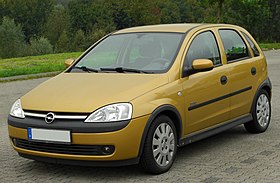 | |
| Overview | |
| Model code | X01 |
| Also called | Chevrolet Corsa Holden Barina Opel Vita (Japan) Vauxhall Corsa |
| Production | 2000–2007 (Europe) 2002–2012 (South America) |
| Assembly |
|
| Body and chassis | |
| Body style | 3- and 5-door hatchback 4-door saloon 3-door car-derived van 2-door coupé utility (pick up) |
| Platform | Gamma platform |
| Related | Opel Combo C Opel Meriva A Opel Tigra TwinTop B |
| Powertrain | |
| Engine | |
| Transmission | 5-speed manual 4-speed automatic 5-speed automated manual |
| Dimensions | |
| Wheelbase | 2,491 mm (98.1 in) |
| Length | 3,817 mm (150.3 in) (hatchback)[45] 4,181 mm (164.6 in) (saloon) |
| Width | 1,645 mm (64.8 in) |
| Height | 1,440 mm (56.7 in) 1,430 mm (56.3 in) (saloon) |
| Chronology | |
| Successor | Chevrolet Agile (South America) |
The Corsa C was revealed in 1999, and introduced to the European market in October 2000, and the facelift arrived in August 2003.[46] General Motors dubbed the new chassis Gamma, and intended to use it for a number of other models. A saloon version was also offered in Latin America, South Africa and the Middle East. In 2002, the Corsa chassis spawned a mini MPV called the Opel Meriva, development of which began under Opel in Rüsselsheim.[citation needed] In Japan, where the car was sold through Yanase as the Opel Vita, where it was discontinued in April 2004 due to sluggish sales.
The vehicle won 2001 Semperit Irish Car of the Year in Ireland.
-
Opel Corsa five-door (2000–2004)
-
Opel Corsa three-door (2000–2004)
-
Opel Corsa three-door (2004–2007)
-
Opel Corsa three-door (2004–2007)
-
Opel Corsa five-door (2003–2007)
-
Pre facelift Vauxhall Corsa
-
Post facelift Vauxhall Corsa
-
Holden Barina five-door (pre-facelift)
-
Holden Barina three-door (facelift)
-
Interior
Safety
[edit]Euro NCAP test results for a LHD, three-door hatchback variant on a registration from 2002:
| Test[47] | Score | Points |
|---|---|---|
| Overall: | N/A | N/A |
| Adult occupant: | 25 | |
| Child occupant: | N/A | N/A |
| Pedestrian: | 9 | |
| Safety assist: | N/A | N/A |
Brazil
[edit]The Brazilian version of the Corsa sold in those countries featured a more conservative front end than its European counterpart.
Brazil also offered a pickup truck version of the Corsa named the Chevrolet Montana (sold in some markets as the Tornado), which, as well as the saloon, was exported in a completely knocked down form to South Africa for local assembly.
Mexico
[edit]The Corsa C arrived in the 2002 model year as a five-door hatchback, and was imported from Europe; but for the model year of 2003, the Corsa sold in Mexico began coming from Brazil and a saloon version was added. In 2005, the saloon version introduced an automated manual transmission called Easytronic because it was only offered in a five-speed manual transmission, however, the easytronic transmission was rapidly discontinued after the model year of 2007, because of poor sales and technical flaws.[citation needed]
For 2008, the Corsa was tweaked with a freshened grille, lights, and a gold-coloured Chevrolet logo. The Chevrolet Corsa C was discontinued in the Mexican market in June 2008, leaving only the older and freshened Chevy (Corsa B); and the Corsa C was replaced by the Chevrolet Aveo, however, Brazil kept the car until 2012 (as the Chevrolet Corsa Final Edition and with the saloon ending in 2011) and Argentina kept the car until 2010, while the Corsa-based Montana continued into 2010.
The Corsa C was that was sold in South America, was produced at the Rosario production plant in Argentina. The Latin American Corsa C featured the Opel inspired Chevrolet logo with a golden bowtie instead of a chromed one – the new logo was first introduced in the South American market with the new Chevrolet Vectra.
-
Chevrolet Corsa five-door
-
Chevrolet Corsa saloon
-
Chevrolet Corsa saloon
-
Chevrolet Montana pickup truck
South Africa
[edit]GM South Africa initially marketed the hatchback simply as the "New Corsa", later reverting to Corsa, while the previous generation Corsa B was still sold alongside the Corsa C and was branded as Corsa "Lite". A five-door hatchback (three-door was never offered) and four-door sedan as well as a pickup version known as the Corsa Utility was offered. In 2007, the Corsa C saloon was dropped in South Africa. The Corsa hatchback in South Africa did not have the same front fascia as the European Corsa. Instead, it had the same front fascia as the Latin American Chevrolet Corsa. Petrol engines were largely a carry over of the 8 valve SOHC variants from the Corsa B sold in South Africa, in displacements of 1.4L (65 kW), 1.6L (75 kW) and 1.8L (79 kW), the 1.8L was new for the Corsa C offered in range topping models, while this engine was never offered with a Corsa B, it was just a larger bore/stroke version of the existing engines. A 1.7DTi diesel was initially offered, with the a new 1.7CDTi diesel engine being added later.
Oceania
[edit]In Australia, the car was launched to much fanfare from many motor journalists, and went on to win the Wheels 2001 "Car of the Year" (COTY). Holden also imported the SRi version with the 1.8L Astra motor and uprated sports suspension including traction control, ABS brakes, a better tyre/wheel combination, and Irmscher body kit to produce a "baby hot hatch" Barina.
The facelifted 2004 model was also imported; however, in December 2005, the Corsa C was suddenly dropped from the Australian and New Zealand Holden ranges as a cost-cutting measure by GM and was replaced by the Daewoo Kalos, rebadged as a Holden Barina. Motoring journalists were scathing in their criticism of the new model, particularly the bland handling, lackluster engine, and below-par safety features. The Kalos-based Barina was subsequently replaced with a rebadged version of the Chevrolet Sonic/Daewoo Kalos T300 until stocks ran out in early 2019.
United Kingdom
[edit]This generation of the Corsa was a huge success for Vauxhall in the United Kingdom, which is the most popular supermini and second most popular car overall in 2002, 2003 and 2004. It was also Britain's best-selling supermini in 2005, achieving third place overall, but in 2006 (the final year of production) it lost top place in the supermini sector after five years and was overtaken by the Ford Fiesta. Overall, it was Britain's fourth most popular car in 2006.
Engine specifications
[edit]The Corsa C was introduced with a 1.7 L DTI Ecotec turbodiesel engine supplied by Isuzu (Circle L) with 75 hp (55 kW). This was later joined by the 1.7 L DI Ecotec turbodiesel engine also supplied by Isuzu. The 1.7 L DI Ecotec did not include an intercooler and this reduced power to 65 PS (48 kW).[48] From 2003, a new 1.3 L CDTI Ecotec turbodiesel engine was supplied by Fiat (MultiJet) which produced 70 PS (51 kW) and a 1.7 L CDTI Ecotec turbodiesel was supplied by Isuzu which produced 100 PS (74 kW). This new 1.7 L CDTI Ecotec featured a variable geometry turbocharger.[49]
The 1.0 L and 1.2 L Ecotec Family 0 engines are carry overs from the Corsa B; the 1.4 L Family 1 engine was replaced with a new 1.4 L Family 0 model. The 1.8 L Family 1 engine is an upgrade for the previous 1.6 L 16 valve engine and produces 125 PS (92 kW) and 165 N⋅m (122 lb⋅ft) of torque. The edition with the 1.8 L engine was named Corsa GSi and was the predecessor of the new Corsa OPC.
In 2003, Opel introduced updated versions of Family 0 engines with TwinPort technology, and the 1.2 L engine gained 30 cc, giving it 80 PS (59 kW).
| Petrol engines | ||||||
|---|---|---|---|---|---|---|
| Model | Production | Engine | Displacement | Power | Torque | Note |
| 1.0 Ecotec | 2000–2003 | I3 | 973 cc | 58 PS (43 kW; 57 hp) at 5600 rpm | 85 N⋅m (63 lb⋅ft) at 3800 rpm | |
| 1.0 Ecotec | 2003–2006 | I3 | 998 cc | 60 PS (44 kW; 59 hp) at 5600 rpm | 88 N⋅m (65 lb⋅ft) at 3800 rpm | Twinport |
| 1.2 Ecotec | 2000–2004 | I4 | 1,199 cc | 75 PS (55 kW; 74 hp) at 5600 rpm | 110 N⋅m (81 lb⋅ft) at 4000 rpm | |
| 1.2 Ecotec | 2004–2006 | I4 | 1,229 cc | 80 PS (59 kW; 79 hp) at 5600 rpm | 110 N⋅m (81 lb⋅ft) at 4000 rpm | Twinport |
| 1.4 Ecotec | 2000–2003 | I4 | 1,389 cc | 90 PS (66 kW; 89 hp) at 6000 rpm | 125 N⋅m (92 lb⋅ft) at 4000 rpm | |
| 1.4 Ecotec | 2003–2006 | I4 | 1,364 cc | 90 PS (66 kW; 89 hp) at 5600 rpm | 125 N⋅m (92 lb⋅ft) at 4000 rpm | Twinport |
| 1.8 Ecotec | 2000–2003 | I4 | 1,796 cc | 125 PS (92 kW; 123 hp) at 6000 rpm | 165 N⋅m (122 lb⋅ft) at 4600 rpm | GSi |
| Brazilian engines | ||||||
| 1.0 L 8V VHC | 2002–2005 | I4 | 71 PS (52 kW; 70 hp) | Joy | ||
| 1.0 L 8V VHC FlexPower | 2006–2009 | I4 | 77–78 PS (57–57 kW; 76–77 hp) | Joy/Maxx | ||
| 1.4 L 8V Econo.Flex | 2008–2012 | I4 | 99–105 PS (73–77 kW; 98–104 hp) | Maxx/Premium | ||
| 1.8 L 8V MPFI | 2002–2005 | I4 | 102 PS (75 kW; 101 hp) | Premium/SS | ||
| 1.8 L 8V FlexPower | 2005–2009 | I4 | 116–120 PS (85–88 kW; 114–118 hp) | Maxx/Premium/SS | ||
| Diesel engines | ||||||
| Model | Production | Engine | Displacement | Power | Torque | Note |
| 1.3 CDTI Ecotec | 2003–2006 Z13DT | I4 | 1,248 cc | 70 PS (51 kW; 69 hp) at 4000 rpm | 170 N⋅m (125 lb⋅ft) at 1750–2500 rpm | Fiat engine |
| 1.7 DI | 2000–2003 Y17DTL | I4 | 1,686 cc | 65 PS (48 kW; 64 hp) at 4400 rpm | 130 N⋅m (96 lb⋅ft) at 2000–3000 rpm | No intercooler |
| 1.7 DTI | 2000–2003 Y17DT | I4 | 1,686 cc | 75 PS (55 kW; 74 hp) at 4400 rpm | 165 N⋅m (122 lb⋅ft) at 1800–3000 rpm | |
| 1.7 CDTI Ecotec | 2003–2005 Z17DTH | I4 | 1,686 cc | 100 PS (74 kW; 99 hp) at 4400 rpm | 240 N⋅m (177 lb⋅ft) at 2300 rpm | VGT |
Corsa D (S07; 2006)
[edit]| Corsa D | |
|---|---|
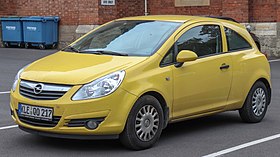 | |
| Overview | |
| Model code | S07 |
| Also called | Vauxhall Corsa Chevrolet Viva (cancelled) JL X340 (2002) |
| Production | 2006–2014 |
| Assembly | |
| Designer | Niels Loeb Dietmar Finger (interior, 2004) |
| Body and chassis | |
| Body style | 3 and 5-door hatchback 3-door car-derived van |
| Platform | SCCS platform |
| Related | Fiat Punto Alfa Romeo MiTo |
| Powertrain | |
| Engine |
|
| Transmission |
|
| Dimensions | |
| Wheelbase | 2,511 mm (98.9 in) |
| Length | 3,999 mm (157.4 in) |
| Width | 1,737 mm (68.4 in) |
| Height | 1,488 mm (58.6 in) |
| Curb weight | 1,100 kg (2,425 lb) |
The Corsa D was created using a new version of the SCCS platform, which was co-developed by General Motors/Opel and Fiat,[50] and is also employed by the 2005 Fiat Grande Punto. The first official pictures of the Corsa D were released by Opel in May 2006. In the United Kingdom, What Car? awarded it 2007 Car of the Year. The Corsa D placed second in the European Car of the Year for 2007, only behind the Ford S-Max.
The Corsa D is available in both three and five-door versions and marketed as the Vauxhall Corsa in the United Kingdom. The same engines sizes from the Corsa C were available at launch, although the 1.3 L CDTI and 1.7 L CDTI engines were upgraded, with power ranging from 75 PS (55 kW) to 125 PS (92 kW).
The 192 PS (141 kW) OPC/VXR version went on sale in the beginning of 2007, with a 1.6 L turbocharged petrol engine powering the front wheels.
The 75 PS (55 kW) 1.3 CDTI engine was updated in the middle of 2007 to bring CO2 levels to just 119 g/km, meaning that twelve months' Vehicle Excise Duty in the United Kingdom costs £30 and is eligible for the Plan 2000E (a rebate of €2000 in the purchase of a new car) in Spain.[51]
The Corsa D was briefly available in Australia under the Opel brand name, rather than as a Holden as the Corsa B and C had previously been, during Opel's short-lived foray into the Australian market. Less than a year after launching, Opel Australia announced it was ceasing operations, removing the Corsa from the Australian market.
The Corsa D was never available in Japan, as Yanase had stopped importing the Opel Vita in April 2004, due to declining sales. Opel withdrew altogether from the Japanese market in December 2006, due to low sales the previous year.
At an early stage of the Corsa D's development in 2004, Dietmar Finger was tasked to design the outer panel for the glove box in the Corsa. Allegedly, his son suggested drawing a shark instead. The designer managed to hide it so well, on the hinge of the glove compartment that it was never removed, and featured on all production models.[52] The custom of having a shark graphic in the interior continued for other Opel cars even after Opel has been taken over by PSA.[53]
-
Opel Corsa (three-door)
-
Opel Corsa (five-door)
-
Dashboard
-
Opel Corsa OPC
-
Rear view
-
Opel Corsa GSi
-
Vauxhall Corsa SXi
-
Vauxhall Corsa VXR
Safety
[edit]Euro NCAP test results for a LHD, three-door hatchback variant on a registration from 2006:
| Test[54] | Score | Points |
|---|---|---|
| Overall: | N/A | N/A |
| Adult occupant: | 34 | |
| Child occupant: | 32 | |
| Pedestrian: | 19 | |
| Safety assist: | N/A | N/A |
FlexFix
[edit]FlexFix is an optional integrated bicycle rack. It is essentially a concealed drawer that can be pulled out from the car's rear bumper. Attached are two-wheel mount bike racks, rear number plate incorporated in the system, brake/tail lights, indicators and fog and reverse light alternates in left-hand drive and right-hand drive cars. It is available as an option on Exclusiv, SE, and SXi models in the United Kingdom.
OPC/VXR
[edit]In 2007, Opel introduced a sport version of the Corsa tuned by Opel Performance Center (OPC) – Corsa OPC. This Corsa has a 1.6 litre I4 turbo engine with 141 kW (192 PS; 189 hp) at 5,850 rpm and 230 N⋅m (170 lb⋅ft) of torque at 1,980 to 5,850 rpm, with an overboost function which boosts up the torque figure to 266 N⋅m (196 lb⋅ft). The 0 to 100 km/h (62 mph) time is 7.2 seconds and top speed is 225 km/h (140 mph). Differences from the standard Corsa in the interior are sporty Recaro seats, OPC steering wheel and gear knob and instrument dials with OPC background.
On the exterior, there are different front and rear bumpers with triangle-shaped exhaust, and wind diffusers. There are also OPC tail spoilers and skirts. The car has stiffer and lower suspension than the regular Corsa as well. Standard rims are 17 inches and an optional 18 inches. The Corsa OPC was only available as a three-door version.
OPC/VXR Nürburgring Edition
[edit]
The Opel Performance Center in 2011 launched a hardcore version of the Corsa OPC called the Corsa OPC Nürburgring Edition. The engine is the same, 1.6 litre turbo, but it has been tuned to punch out 210 PS (154 kW; 207 hp) and 250 Nm (280 Nm with overboost function) of torque at 2,250 to 5,850 rpm. The 0–100 km/h time is 6.8 seconds and top speed is 230 km/h (143 mph).
New upgrades include Brembo brake packages, recalibrated ABS, traction stability management system, Remus exhaust, Bilstein suspension, and a mechanical limited slip differential, which in this segment of cars (supermini/B segment), only the MINI Cooper JCW has.[55]
This Corsa comes with a standard 18-inch alloy wheels and low profile tires, lowered suspension, dual tipped stainless steel exhaust, and special Nurburgring badge at B pillars and inside on gear knob and instrument dials. Also included is a new front spoiler, and different rear bumper. This Corsa is available in Henna Red, Grasshopper Green, Graphite Black (available as matte colour), and Casablanca White.[56]
Engines
[edit]Petrol engines are Family 0 (1.0–1.4) and Family 1 (1.6), and diesel engines are derivative from MultiJet (1.3) and Circle L (1.7).
| Petrol engines | ||||||
|---|---|---|---|---|---|---|
| Model | Engine | Displacement | Power | Torque | Note | CO2 emissions |
| 1.0 | I3 Z10XEP | 998 cc | 60 PS (44 kW; 59 hp) at 5600 rpm | 88 N⋅m (65 lb⋅ft) at 3800 rpm | 2006-2009 | 134 g/km |
| 1.2 | I4 Z12XEP | 1229 cc | 80 PS (59 kW; 79 hp) at 5600 rpm | 110 N⋅m (81 lb⋅ft) at 4400 rpm | 2006-2009 | 139 g/km |
| 1.4 | I4 Z14XEP | 1364 cc | 90 PS (66 kW; 89 hp) at 5600 rpm | 125 N⋅m (92 lb⋅ft) at 4000 rpm | 2006-2009 | 139 g/km |
| 1.6T | I4 Z16LEL | 1598 cc | 150 PS (110 kW; 148 hp) at 5000 rpm | 210 N⋅m (155 lb⋅ft) at 1850–5000 rpm | GSi/SRi | 189 g/km |
| 1.6T OPC/VXR | I4 Z16LER | 1598 cc | 192 PS (141 kW; 189 hp) at 5850 rpm | 230 N⋅m (170 lb⋅ft) at 1980–5800 rpm | OPC/VXR | 190 g/km |
| Diesel engines | ||||||
| Model | Engine | Displacement | Power | Torque | Note | CO2 emissions |
| 1.3 CDTI | I4 Z13DTJ | 1,248 cc | 75 PS (55 kW; 74 hp) at 4,000 rpm | 170 N⋅m (125 lb⋅ft) at 1,750–2,500 rpm | 119 g/km | |
| 1.3 CDTI | I4 Z13DTH | 1,248 cc | 90 PS (66 kW; 89 hp) at 4,000 rpm | 200 N⋅m (148 lb⋅ft) at 1,750–2,500 rpm | 127 g/km | |
| 1.7 CDTI | I4 Z17DTR | 1,686 cc | 125 PS (92 kW; 123 hp) at 4,000 rpm | 280 N⋅m (207 lb⋅ft) at 2,300 rpm | 130 g/km | |
Facelift
[edit]The Opel Corsa boasted a new petrol and diesel engine line up that fully complies with Euro 5 standards. The ride and handling were also improved.[57] Engines were further improved from 2011 as Start/Stop was added to engines, with all engines expecting to get the technology in the future.
Engines with (S/S) are in bold in CO2 column
| Petrol engines | ||||||
|---|---|---|---|---|---|---|
| Model | Engine | Displacement | Power | Torque | Note | CO2 emissions |
| 1.0 S&S | I3 | 998 cc | 65 PS (48 kW; 64 hp) at 5,300 rpm | 90 N⋅m (66 lb⋅ft) at 4,000 rpm | Twinport | 117 |
| 1.2 VVT | I4 | 1,229 cc | 85 PS (63 kW; 84 hp) at 5,600 rpm | 115 N⋅m (85 lb⋅ft) at 4,400 rpm | 124/129 (2010–) 119 g/km (2011–) | |
| 1.4 VVT | 1,398 cc | 100 PS (74 kW; 99 hp) at 5,600 rpm | 130 N⋅m (96 lb⋅ft) at 4,000 rpm | 129 g/km | ||
| 1.4 T S&S | 1,368 cc | 120 PS (88 kW; 118 hp) at 4,800–6,000 rpm | 175 N⋅m (129 lb⋅ft) at 1,750–4,800 rpm | 2012– | 129 g/km | |
| 1.6T | 1,598 cc | 150 PS (110 kW; 148 hp) at 5,000 rpm | 210 N⋅m (155 lb⋅ft) at 1,850–5,000 rpm | GSi | 171 g/km | |
| 192 PS (141 kW; 189 hp) at 5,850 rpm | 230 N⋅m (170 lb⋅ft) at 1,980–5,800 rpm | OPC/VXR | 172 g/km | |||
| 210 PS (154 kW; 207 hp) at 5,850 rpm | 250 N⋅m (184 lb⋅ft) at 2,250–5,850 rpm | OPC Nürburgring Edition | 178 g/km | |||
| Diesel engines | ||||||
| Model | Engine | Displacement | Power | Torque | Note | CO2 emissions |
| 1.3 CDTI ecoFLEX | I4 | 1,248 cc | 75 PS (55 kW; 74 hp) at 4,000 rpm | 190 N⋅m (140 lb⋅ft) at 1,750–2,500 rpm | 112 g/km (2010–) 105 g/km (2011–) | |
| 95 PS (70 kW; 94 hp) at 4,000 rpm | 210 N⋅m (155 lb⋅ft) at 1,750–2,500 rpm | 115 g/km (2010–) 95 g/km (2011–) | ||||
| 1.7 CDTI ecoFLEX | 1,686 cc | 130 PS (96 kW; 128 hp) at 4,000 rpm | 300 N⋅m (221 lb⋅ft) at 2,000–2,500 rpm | 118 g/km | ||
Hybrid
[edit]At the 2007 Frankfurt Motor Show, Opel unveiled the Opel Corsa Hybrid Concept, a coupe that combines a belt-driven starter and alternator with a lithium-ion battery.[58]
Facelift
[edit]In November 2010, a facelift was announced. A revised front end was the most dramatic difference over its predecessor, consisting of a new grille, a restyled front bumper and new 'Eagle Eye' headlamps (introduced on the Insignia) which contain daytime running lamps, standard across the refreshed Corsa range. (Vauxhall versions gained the latest badge from 2008 on the front grille, tailgate and steering wheel). A new 'Touch and Connect' multimedia system from Bosch was made available as an option on certain Corsas, replacing the CD60 unit.[59] Alloy wheels are upgraded on SXI, SE, SRi and OPC/VXR versions. Production ended in the end of 2014, with the Adam styled Corsa E released.[60]
-
Opel Corsa (three-door)
-
Opel Corsa (three-door)
-
Opel Corsa (five-door)
-
Opel Corsa OPC Nürburgring Edition since 2011
-
Rear view
-
Vauxhall Corsa
-
2012_Opel_Corsa
Corsa E (X15; 2014)
[edit]| Corsa E | |
|---|---|
 | |
| Overview | |
| Model code | X15 |
| Also called | Vauxhall Corsa |
| Production | 2014–2019 |
| Assembly |
|
| Designer | Carsten Aengenheyster[61] |
| Body and chassis | |
| Body style | 3 and 5-door hatchback 3-door car-derived van |
| Platform | SCCS platform |
| Related | Opel Adam |
| Powertrain | |
| Engine |
|
| Transmission |
|
| Dimensions | |
| Wheelbase | 2,510 mm (98.8 in) |
| Length | 4,021 mm (158.3 in) |
| Width | 1,736–1,746 mm (68.3–68.7 in) |
| Height | 1,479–1,481 mm (58.2–58.3 in) |
| Curb weight | 1,120–1,237 kg (2,469–2,727 lb) |
The Corsa E[62] debuted at the 2014 Paris Motor Show.[63]
Interior space stayed the same, as did the 285-litre boot, but the interior was completely new.[64] All of the exterior sheet metal (except the roof) was revised, but the underlying chassis and body structure, the glasshouse, as well as some minor parts such as side-view mirrors and turn signal repeaters, were carried over from the Corsa D.[65]
-
Vauxhall Corsa Mk IV
-
Vauxhall Corsa Mk IV (3-door)
-
Vauxhall Corsavan Mk IV
-
Vauxhall Corsa Mk IV VXR
-
Interior
-
Opel Corsa E 1.4 Turbo ecoFLEX (rear view)
Safety
[edit]The Corsa in its standard European market configuration received 4 stars from Euro NCAP in 2014.[66]
Corsa OPC/VXR
[edit]In February 2015, Opel introduced OPC version of Corsa E. Compared to the previous generation model, power output had increased by 15PS to 207PS (204 bhp) from 1.6 Turbo engine, with a maximum torque of 245 Nm (181 lb-ft) between 1900 and 5800 rpm. An overboost function increased torque to 280Nm (210 lb-ft) when needed. As a result, the Corsa OPC was able to sprint from 0 to 100 km/h (62 mph) in 6.8 seconds and to reach a maximum speed of 230 km/h (143 mph).
The Corsa OPC featured a sports chassis with Frequency Selective Damping (FSD) technology, which enabled the damping forces to adapt to the frequency of the car to balance sportiness with comfort. The suspension was lowered by 10mm (0.39 in) compared to standard Corsa models, and the car also received an optimised steering system with more direct and precise reactions. OPC also worked on the brakes, adding 308mm discs on the front axle.
Opel also offered the Corsa OPC Performance Package, which included a mechanical multi-disc differential lock made by Drexler, 18-inch wheels with Michelin tires, and an even more athletic chassis set up. The package also brought a Brembo high-performance braking system with 330mm braking discs on the front axle.
Styling-wise, the Corsa OPC/VXR received more aggressive body kits with new bumpers, aluminium frames for the fog lights, a small scoop in the hood, a big roof spoiler, and twin-pipe Remus exhaust with a diffuser. Inside, the Recaro performance seats took centre stage, with other upgrades including the flat-bottomed leather steering wheel, OPC gear knob, and sports pedals, as well as OPC design instruments.
Engines
[edit]Under the bonnet, all new 1.0-litre three-cylinder ECOTEC engine – the direct-injection turbo offered 90 PS or 115 PS – both giving 170Nm of torque – with a six-speed manual 'box, while a new six-speed auto was optional on selected engines. Start/Stop tech as standard and, in three-door guise, the lower-powered model could hit sub-100g/km CO2 emissions.
The entry-level engine was a 70 PS 1.2-litre petrol, while turbo and non-turbo 1.4s offered 100 PS and 90 PS respectively. The 1.3 CDTI continued with 75PS, now hitting as little as 85g/km CO2 emissions, and was capable of 3.2 L/100 km economy. An ecoFLEX version was available from launch, too, with target CO2 emissions of under 85g/km.
| Petrol engines | ||||||
|---|---|---|---|---|---|---|
| Model | Engine | Displacement | Power | Torque | Note | CO2 emissions |
| 1.0T SIDI S/S | I3 | 999 cc | 90 PS (66 kW; 89 hp) at 3700–6000 rpm | 170 N⋅m (125 lb⋅ft) at 1800–3700 rpm | 102–100 g/km | |
| 115 PS (85 kW; 113 hp) at 5000–6000 rpm | 170 N⋅m (125 lb⋅ft) at 1800–4500 rpm | 115–114 g/km | ||||
| 1.2 | I4 | 1229 cc | 70 PS (51 kW; 69 hp) at 5600 rpm | 115 N⋅m (85 lb⋅ft) at 4000 rpm | Only Available for short time after release in hatchbacks then the engine was dropped in 2018 | 126–124 g/km |
| 1.4 | 1398 cc | 90 PS (66 kW; 89 hp) at 6000 rpm | 130 N⋅m (96 lb⋅ft) at 4000 rpm | 114–129 g/km | ||
| 1.4 Turbo | 1364 cc | 100 PS (74 kW; 99 hp) at 3500–6000 rpm | 200 N⋅m (148 lb⋅ft) at 1850–3500 rpm | 122–119 g/km | ||
| 1.6 Turbo (B16LER) | 1598 cc | 207 PS (152 kW; 204 hp) at 5850 rpm | 245 N⋅m (181 lb⋅ft) (overboost 280 (207)) at 1900–5800 rpm | OPC/VXR | 174 g/km | |
| Diesel engines | ||||||
| Model | Engine | Displacement | Power | Torque | Note | CO2 emissions |
| 1.3 CDTI S/S | I4 | 1248 cc | 75 PS (55 kW; 74 hp) at 3750 rpm | 190 N⋅m (140 lb⋅ft) at 1500–2500 rpm | 100–99 g/km | |
| 95 PS (70 kW; 94 hp) at 3750 rpm | 190 N⋅m (140 lb⋅ft) at 1500–2500 rpm | 82–101 g/km | ||||
Corsa F (P2JO; 2019)
[edit]| Corsa F | |
|---|---|
 | |
| Overview | |
| Model code | P2JO |
| Also called | Vauxhall Corsa |
| Production | 2019–present |
| Assembly | Spain: Zaragoza (Opel Zaragoza) |
| Designer | Martin Schaufler (exterior)[67] |
| Body and chassis | |
| Body style | 5-door hatchback |
| Platform | PSA CMP (EMP1) platform |
| Related | Peugeot 208 Opel Mokka B Lancia Ypsilon IV |
| Powertrain | |
| Engine |
|
| Electric motor | Permanent Magnet Synchronous Motor (Corsa-e) |
| Transmission |
|
| Battery | 50 kWh |
| Electric range | 330 km (210 mi) |
| Dimensions | |
| Wheelbase | 2,538 mm (99.9 in) |
| Length | 4,060 mm (159.8 in) |
| Width | 1,765 mm (69.5 in) |
| Height | 1,435 mm (56.5 in) |
| Kerb weight | 980–1,090 kg (2,161–2,403 lb) |
| Chronology | |
| Predecessor | Opel Adam Opel Karl Opel Ampera-e (electric version) |
The original project of Corsa F (project code: G2J0)[68] was initially planned to be released in the third quarter of 2017 on a GM platform, the G2XX.[69][70] However, the G2J0 project was cancelled due to Groupe PSA's acquisition of Opel and Vauxhall, with the cancelled project reaching production in a sedan form as the Buick Excelle in China.[71] Development was then restarted after switching to the PSA CMP (EMP1) platform in 2017.[72] The Corsa is thus the first of the Opel/Vauxhall models developed under the PSA ownership.[73] The Corsa F was unveiled at the 2019 Frankfurt Motor Show.[74]
-
Vauxhall Corsa (pre-facelift)
-
Rear view (pre-facelift)
-
Interior (Vauxhall Corsa; pre-facelift)
Safety
[edit]The Corsa in its standard European market configuration received 4 stars from Euro NCAP in 2019.[75]
Corsa-e
[edit]In December 2018, Opel announced the launch of an electric version of the Corsa, called the Corsa-e, which was originally planned to go on sale in 2019,[76][77] but was delayed into the second quarter of 2020. In the UK, the Corsa-e is sold under the Vauxhall marque.[78] The main competitors to the Corsa-e were expected to be the Nissan Leaf and the Renault Zoe, as well as its mechanically identical twin, the Peugeot e-208.
The Corsa-e has the same drivetrain as the e-208.[79] The electric motor produces 136 PS (100 kW; 134 hp) and 260 N⋅m (192 lb⋅ft) of torque, and a 0–100 km/h (62 mph) acceleration takes 8.1 seconds. Output is restricted in the Normal (81 kW (109 hp) and 220 N⋅m (162 lb⋅ft) and Eco (60 kW (81 hp) and 180 N⋅m (133 lb⋅ft) modes.[80] Under the WLTP driving cycle, the Corsa-e has an estimated range of 330 km (210 mi) using a 50.0 kW-hr battery (gross),[79] which is carried in the floor.[81] Real-world testing showed the actual efficiency was 3.1 to 3.7 mi (5.0 to 6.0 km) per kW-hr, yielding a range of 145–190 mi (233–306 km) considering the 46 kW-hr usable battery capacity.[78] Over a six-month test, CAR observed an efficiency of 3.9 mi (6.3 km) per kW-hr, slightly less than the claimed 4.18 mi (6.73 km) per kW-hr.[80]
Compared to the conventionally-powered Corsa, the Corsa-e is 345 kg (761 lb) heavier[81] at a kerb weight (for the base model) of 1,455 kg (3,208 lb); the center of gravity is lower by 57 mm (2.2 in) for the Corsa-e.[78] Boot space shrinks from 309 to 267 L (10.9 to 9.4 cu ft) for the electric version as well.[78] Externally, the standard Corsa F is almost identical to the electric version, with the exception of different alloy wheel designs and the lack of exhaust. The interior will include a touchscreen infotainment system with two set-ups available; seven-inch Multimedia Navi system or 10-inch Multimedia Navi Pro (exclusive to the top-level Elite Premium trim).[82]
Interior styling and controls generally are simpler than the e-208.[81] In the UK, the Corsa-e is sold in four trim levels (from base Griffin through SE Premium, SRi Premium, and Elite Premium).[78] Starting price was £30,665, which was reduced to £27,165 with applied government grants.[81]
-
Vauxhall Corsa-e (pre-facelift)
-
Opel Corsa-e in 2014, at Paris Motor Show
Powertrain
[edit]The Corsa F supermini marks the arrival of new petrol and diesel engines as well as an all-electric Corsa-e into the range. Two petrol engines and one diesel engine are available, starting with the 1.2-litre three-cylinder engine that produces 75 bhp and comes with a five-speed manual gearbox as standard. Sitting above is a three-cylinder 1.2-litre turbo PureTech engine which is shared with Peugeot and Citroen models and produces 99 bhp and 205 Nm of torque. It comes with a six-speed manual or eight-speed automatic gearbox option. The diesel engine is a BlueHDi 1.5-litre four-cylinder diesel, producing 99 bhp and 250 Nm of torque.
Weight of the car is also improved, with lightweight underpinnings, redesigned bodyshell and new aluminium engines which Opel claims 10 percent of kerb weight have been reduced across the range and will have a good balance between sportiness and comfort. The body is constructed from a range of high-strength steels, saving a total of 40 kg over the seventh-generation model. A new aluminium bonnet will also replace the previous generation's steel unit, saving a further 2.4 kg. However, the Corsa is slightly larger than its predecessor, with a larger body and longer wheelbase to allocate more interior and boot space.[83]
Opel's latest range of aluminium three-cylinder petrol and diesel engines are projected to save around 15 kg over the predecessor four-cylinder units. 10 kg has been reduced off the seats, losing 5.5 kg at the front and 4.5 kg at the rear, totalling around 108 kg of weight reduction.[84]
In June 2019 it was revealed that first deliveries were scheduled to start in April 2020, while the pure-electric model was planned to follow at a time that has not yet been announced.[85][86]
| Petrol engines | |||||
|---|---|---|---|---|---|
| Model | Engine | Displacement | Power | Torque | CO2 emissions[87] |
| 1.2 | I3 | 1199 cc | 75 PS (55 kW; 74 hp) at 5750 rpm | 118 N⋅m (87 lb⋅ft) at 2750 rpm | 125–126 g/km |
| 1.2 Turbo | 100 PS (74 kW; 99 hp) at 5000 rpm | 205 N⋅m (151 lb⋅ft) at 1750 rpm | 134–135 g/km | ||
| 1.2 Turbo | 130 PS (96 kW; 128 hp) at 5500 rpm | 230 N⋅m (170 lb⋅ft) at 1750 rpm | N/A | ||
| Diesel engine | |||||
| Model | Engine | Displacement | Power | Torque | CO2 emissions |
| 1.5 D | I4 | 1499 cc | 102 PS (75 kW; 101 hp) at 3500 rpm | 250 N⋅m (184 lb⋅ft) at 1750 rpm | 109–110 g/km |
| Electric (Corsa-e) | |||||
| Battery capacity | Power | Torque | All-electric range | ||
| 50 kWh[82] | 136 PS (100 kW; 134 hp)[82] | 260 N⋅m (192 lb⋅ft) | 330 km (205 mi) | ||
Recalls
[edit]On 11 May 2020, Opel recalled Corsas manufactured between 25 September and 30 December 2019 because the steering column was not manufactured according to the specifications, causing steering failure and leading to the car losing control, increasing the risk of an accident.[88]
On 6 November 2020, Opel Corsas manufactured between 18 March 2019 and 14 February 2020 were recalled due to the high-pressure pump not being tightened to the engine with correct torque, causing a potential fuel leak.[89]
Facelift
[edit]A facelift was unveiled on 24 May 2023, featuring a new front fascia features the brand's Visor front end, new exterior colours, a new steering wheel, new shifter for automatic transmission, new seat designs, updated technology and powertrains.[90][91]
In December 2023, Opel announced that the Corsa facelift model could also be ordered in 48V mild-hybrid versions. The assembly is composed of a 1.2-liter gasoline engine, available in 100 and 136 HP versions, a new electrified 6-speed dual-clutch transmission and a 0.4 kWh battery. The electric motor, with 28 HP and 55 Nm, is integrated into the new gearbox.[92]
-
Opel Corsa Electric (facelift)
-
Rear view (facelift)
Corsa Van
[edit]The Corsa Van was a car derived van based on the corresponding generation of the Corsa superminis that was produced from 1983 to 2018. It first appeared in 1983, and was unchanged from the regular car, aside from the panelled rear windows (optional, glazed models were also available) and the missing rear seat. This was replaced by a flat metal loading floor. Payload of the original Corsa A is 405 kg (893 lb) and the entire range of engines was available, at first.[93]
It was usually marketed under the names used in various countries, such as Corsa Lieferwagen (Germany), Bestelwagen (Dutch), or Fourgonnette (French). The Vauxhall version is called the "Corsavan" since 1994, linking it to the earlier Astravan model. Earlier models were called Vauxhall Novavan in the United Kingdom.
Corsa Van variants of later generation Corsas have also been sold under the Opel/Vauxhall[94][95] brand. It was discontinued in 2018.
-
Opel Corsa Van based on third generation (Corsa C)
-
Opel Corsa Van based on fourth generation (Corsa D)
-
Vauxhall Corsavan based on the fifth-generation (Corsa E)
Popularity
[edit]From the first Corsa being sold in the United Kingdom on 2 April 1993, sales had reached 1,371,573 within sixteen years of its launch, by which time the Corsa was in its third generation.
As of 2018, the Vauxhall Corsa was the third most popular car in the United Kingdom, with 1,205,158 taxed and on the road with another 39,286 declared SORN (Statutory Off Road Notification).[96]
In 2021, the Vauxhall Corsa grabbed the top spot for the most popular car of the year having had more new cars registered than any other in the UK throughout 2021. The Corsa managed to achieve 40,914 new registrations throughout the year, beating second place by over 6,000 registrations. This meant that the Ford Fiesta was finally beaten after holding the mantle of most popular car for 12 successive years. In fact, the Ford Fiesta didn't even achieve a top 10 finish after being heavily affected by chip shortages and Ford prioritising sales of more profitable SUVs, such as the Puma.[97]
Notes
[edit]References
[edit]- ^ "Vauxhall Corsa (2014) in pictures: GM's new supermini grows up". CAR Magazine. Retrieved 15 July 2015.
- ^ "New Vauxhall Corsa unveiled at Paris Motor Show". Auto Express. Retrieved 15 July 2015.
- ^ "Vauxhall Corsa hatchback". Carbuyer. Retrieved 15 July 2015.
- ^ Gasnier, Matt (16 January 1999). "World 1998: GM Corsa the best-selling car in the world". Best Selling Cars Blog. Retrieved 21 June 2021.
- ^ "Opel Corsa Celebrates 25th Birthday - Huliq". 17 August 2009.
- ^ Isakson, Börje, ed. (8 September 1982). "Opels Nya småbil Corsa under testtillverkning" [Opel's new minicar Corsa enters test production]. Teknikens Värld (in Swedish). Vol. 34, no. 19. Stockholm, Sweden: Specialtidningsförlaget AB. p. 72.
- ^ McCraw, Jim, ed. (November 1982). ""S" indeed, it's the Opel Corsa". Motor Trend. Vol. 34, no. 11. Petersen Publishing Co. p. 18.
- ^ Visart, Etienne, ed. (28 April 1983). "Opel Corsa op de Belgische markt" [Opel Corsa on the Belgian market]. De AutoGids (in Flemish). 4 (94). Brussels, Belgium: Uitgeverij Auto-Magazine: 78.
- ^ ter Kuile, Caju (24 December 1983). "Rijden met: Opel Corsa 1.3 SR" [Test Ride]. Autovisie (in Dutch). 28 (26). Hilversum, Netherlands: Folio Groep B.V.: 58–59.
- ^ a b "Spanish exports". Motor Business. 109–116: 55. 1982.
- ^ "Opel gives details of car in union row". The Glasgow Herald. Vol. 200, no. 208. 28 September 1982.
- ^ a b Mastrostefano, Raffaele, ed. (1990). Quattroruote: Tutte le Auto del Mondo 1990 (in Italian). Milano: Editoriale Domus S.p.A. p. 688.
- ^ Büschi, Hans-Ulrich, ed. (March 1991). Automobil Revue 1991 (in German and French). Vol. 86. Berne, Switzerland: Hallwag AG. pp. 457–458. ISBN 3-444-00514-8.
- ^ Braithwaite-Smith, Gavin (11 February 2016). "100 popular cars vanishing from our roads". MSN. Retrieved 15 June 2016.
- ^ "The What Van? Road Test: Vauxhall Corsavan Ecoflex". WhatVan?. 18 March 2011. Archived from the original on 26 May 2019.
- ^ "Vauxhall Nova (car) advert 1990 'old style voice-over'". YouTube. 8 March 2017.
- ^ "The Jilin Jiangbei Meilu JJ7090 Was A China-made Opel Corsa B". 13 October 2017.
- ^ "1990 1999". Retrieved 15 July 2015.
- ^ "Gm En Venezuela Y El Mundo – Historia". Gm.com.ve. Archived from the original on 23 March 2010. Retrieved 27 May 2010.
- ^ a b "Opel. Opel in South Africa". Car-cat.com. Archived from the original on 8 July 2011. Retrieved 16 July 2010.
- ^ Satyam. "Welcome to GMArabia.com". Gmegypt.com. Archived from the original on 9 August 2010. Retrieved 19 July 2010.
- ^ "Welcome to Opel India Website". Opel.co.in. Archived from the original on 1 July 2010. Retrieved 19 July 2010.
- ^ "Opel. Opel in India". Car-cat.com. Retrieved 19 July 2010.
- ^ a b c "Opel Corsa specifications". Auto-types.com. Retrieved 20 March 2013.
- ^ a b "Chevrolet Corsa Wind – Ficha técnica". Vrum.com.br. Retrieved 20 March 2013.
- ^ "Chevrolet Corsa Sedan – Ficha técnica". Vrum.com.br. Retrieved 20 March 2013.
- ^ "Chevrolet Corsa Wagon – Ficha técnica". Vrum.com.br. Retrieved 20 March 2013.
- ^ Crouch, Jonathan (8 November 2005). "Vauxhall Corsa (1993 – 2000) review". RAC Limited. Retrieved 12 September 2016.
- ^ "Holden Barina – Used Car Research". GoAuto. Retrieved 12 September 2016.
- ^ Davis, Tony; Kennedy, Alistair; Kennedy, Ewan (February 2007). The Holden Heritage – 13th Edition (Part Three) (PDF). Port Melbourne, Victoria: Holden. p. 101. Archived from the original (PDF) on 25 February 2009.
- ^ "Sketches: A linha Chevrolet dos anos 90 e 2000 nos traços de Wagner Dias". 5 July 2020.
- ^ Ciferri, Luca (7 December 1998). "Italian market takes Corsa Wagon". Automotive News Europe. Crain Communications, Inc. Archived from the original on 27 October 2020.
- ^ Büschi, Hans-Ulrich, ed. (10 March 1994). Automobil Revue 1994 (in German and French). Vol. 89. Berne, Switzerland: Hallwag AG. p. 429. ISBN 3-444-00584-9.
- ^ "All Corsa Forums Performance Stats". Allcorsa.co.uk. 27 May 2011. Retrieved 25 June 2011.
- ^ Mazur, Eligiusz, ed. (2006). "World of Cars 2006·2007". World of Cars: Worldwide Car Catalogue. Warsaw, Poland: Media Connection Sp. z o.o.: 223. ISSN 1734-2945.
- ^ "Después de 18 años, el Chevrolet Classic dejó de fabricarse en Argentina". 19 October 2016.
- ^ "1997 Euro NCAP". Retrieved 23 October 2011.
- ^ "2000 Euro NCAP". Retrieved 23 October 2011.
- ^ "Official results of the Chevrolet Corsa Classic - NO Airbags 2011". LATIN NCAP - PARA AUTOS MAS SEGUROS.
- ^ "South Africa Corsa B (three-door hatch) specifications" (PDF). Delta Motor Corporation. March 2002. Archived from the original (PDF) on 6 February 2005.
- ^ a b Mazur, Eligiusz, ed. (2002). "Katalog Samochody Świata 2003" [World Car Catalogue 2003]. Samochody Świata. Warsaw, Poland: Print Shops Prego - Polska Sp. z o.o.: 217. ISSN 1234-8198.
- ^ "Shanghai-GM: Chevrolet Sails to Chile and Libya". ChinaAutoWeb.com.
- ^ "Chevrolet Sail: Created In China". The Truth About Cars. 12 January 2010. Retrieved 12 January 2010.
- ^ "Opel. Opel in Spain". Car-cat.com. Retrieved 19 July 2010.
- ^ "Opel Corsa C dimensions and blueprints on Outlines". getoutlines.com. Retrieved 25 March 2015.
- ^ Dredge, Richard (21 November 2007). "Used Car Tests: Vauxhall Corsa". Auto Express. Dennis Publishing. Archived from the original on 29 August 2017.
- ^ "Opel/Vauxhall Corsa". Euro NCAP. Retrieved 21 January 2012.
- ^ "2001 Opel Corsa press release". Archived from the original on 3 May 2007. Retrieved 21 July 2008.
- ^ "2003 Opel Corsa press release". Archived from the original on 19 June 2007. Retrieved 21 July 2008.
- ^ "Fiat-General Motors Insieme Nelle utilitarie". Corriere Della Sera. 24 December 2009. Retrieved 6 October 2012.
- ^ "Plan 2000E, ayudas a la Compra de automoviles". Retrieved 31 January 2012.
- ^ "Look Closely And You'll Find Shark-Shaped Easter Eggs In Most New Opels". Carscoops. 29 March 2018. Retrieved 26 June 2020.
- ^ "Shark Attack: Where Are the Predators in the New Opel Grandland X? | Media OPEL International". int-media.opel.com. Retrieved 26 June 2020.
- ^ "Opel/Vauxhall Corsa". Euro NCAP. Retrieved 21 January 2012.
- ^ Minis mit uber 200PS, Auto Bild, archived from the original on 19 March 2012, retrieved 15 March 2012
- ^ Opel Introduces Corsa OPC Nürburgring Edition, GM Authority, 25 April 2011, retrieved 25 April 2011
- ^ Opel introduces updated Corsa ecoFlex with 98 g/km CO2, Autoblog Green, retrieved 22 November 2009
- ^ "GM Media Online". Archived from the original on 13 December 2007.
- ^ "Bosch Media Service" (in German). Bosch-presse.de. Retrieved 17 October 2012.
- ^ Luke Madden (7 December 2012). "New Vauxhall Corsa". Auto Express. Retrieved 30 October 2013.
- ^ US D732433, Aengenheyster, Carsten, "Motor car", published 2015-06-23, assigned to GM Global Technology Operations LLC
- ^ "Opel Corsa: A Success Story in Five Acts". media.gm.com. Retrieved 15 July 2015.
- ^ "Opel Pressroom - Europe - Corsa". gm.com.
- ^ "New Vauxhall Corsa unveiled at Paris Motor Show". Auto Express. Retrieved 15 July 2015.
- ^ Fung, Derek (9 July 2014). "2015 Opel/Vauxhall Corsa E: facelift looks sort of new, is sort of old". Between the Axles. Retrieved 12 August 2014.
- ^ "Official Opel/Vauxhall Corsa 2014 safety rating results". www.euroncap.com.
- ^ "Interview : Martin Schaufler, external designer of the Corsa 2019 - LIGNES/auto". lignesauto.fr. 10 December 2019. Retrieved 25 May 2021.
- ^ "General Motors' future platforms - a go-to guide". www.just-auto.com. 18 May 2016. Retrieved 27 November 2020.
- ^ Panait, Mircea (28 November 2019). "2020 Corsa Offers "More Personalization Options" Than Every Opel Corsa Before It". autoevolution. Retrieved 27 November 2020.
- ^ "PARIS PREVIEW: Redesigned Opel-Vauxhall Corsa to retain Fiat-GM platform". www.just-auto.com. 5 June 2014. Retrieved 27 November 2020.
- ^ Radu, Mihnea (25 April 2019). "2020 Opel Corsa Was Leaked by the Buick Excelle... But We Didn't Notice". autoevolution. Retrieved 4 May 2022.
- ^ "The all-new Opel Corsa F comes on a PSA platform in 2019". 23 November 2017.
- ^ "2019 Opel Corsa Is First New Model From Brand Under PSA Ownership". GM Authority. 23 May 2019. Retrieved 7 June 2020.
- ^ "2020 Opel Corsa Is Finally All-New, Debuts Later This Year". Carscoops. 25 February 2019. Retrieved 14 June 2019.
- ^ "Official Opel/Vauxhall Corsa 2019 safety rating". www.euroncap.com.
- ^ "Opel | Stellantis". www.media.stellantis.com.
- ^ Corsa-e, Opel. "Opel Starts Production Of New Corsa, Corsa-e To Follow Soon". InsideEVs. Retrieved 7 June 2020.
- ^ a b c d e Saunders, Matt. "Vauxhall Corsa-e review". Autocar. Retrieved 10 June 2022.
- ^ a b Golson, Daniel (23 May 2019). "The Electric Opel Corsa-e Is Only for Europe, but We Love It Anyway". Car and Driver. Retrieved 10 June 2022.
- ^ a b Whitworth, Ben (28 October 2021). "Vauxhall Corsa-e long-term test: the six-month verdict". Car. Retrieved 10 June 2022.
- ^ a b c d "Vauxhall Corsa-e review". TopGear. 10 March 2020. Retrieved 10 June 2022.
- ^ a b c "The Electric Car for Everyone: New Opel Corsa-e for €29,900 | Media OPEL International". int-media.opel.com. Retrieved 7 June 2020.
- ^ Aucock, Richard (21 November 2019). "2020 Vauxhall Corsa review: testing the impressive new 'people's car'". Motoring Research. Retrieved 7 June 2020.
- ^ Opel. "2020 Opel Corsa Going On A Strict Diet To Cut Fat". Motor1.com. Retrieved 7 June 2020.
- ^ Burn, Jonathan (26 June 2019). "New 2020 Opel Corsa: engines, tech and release date announced". Auto Express. Retrieved 26 June 2019.
- ^ "New Vauxhall Corsa: full engine range details released | Autocar". www.autocar.co.uk. No. 26 June 2019. Retrieved 26 June 2019.
- ^ "Opel Corsa | Configurator | Opel Ireland". www.opel.ie. Retrieved 7 June 2020.
- ^ "Opel Corsa (2019 - 2020)". Car-Recalls.eu. 11 May 2020.
- ^ "Opel Corsa (2019 - 2020) « Car-Recalls.eu". 6 November 2020.
- ^ Pappas, Thanos (24 May 2023). "2024 Opel Corsa Wears A Redesigned Face, Gains New Electric And Mild-Hybrid Options". Carscoops.
- ^ "2024 Opel Corsa Facelift Debuts With Updated ICE And EV Models". Motor1.com. 24 May 2023.
- ^ "PREMIERĂ: Opel Corsa, disponibil în versiuni mild-hybrid cu până la 136 CP".
- ^ "Corsa Lieferwagen" [Corsa delivery van]. Opel Corsa A (in German). Retrieved 11 January 2018.
- ^ "Corsavan – Small Van of the Year 2008". Automobiles Review. 10 December 2008. Retrieved 14 September 2009.
- ^ "Opel Malta". Opel.com.mt. Archived from the original on 30 August 2009. Retrieved 14 September 2009.
- ^ "icLiverpool – Recession-proof wise-buys revealed". Icliverpool.icnetwork.co.uk. 17 March 2009. Archived from the original on 29 September 2010. Retrieved 27 May 2010.
- ^ "SMMT - Car Registrations". smmt.co.uk. Retrieved 22 January 2022.

